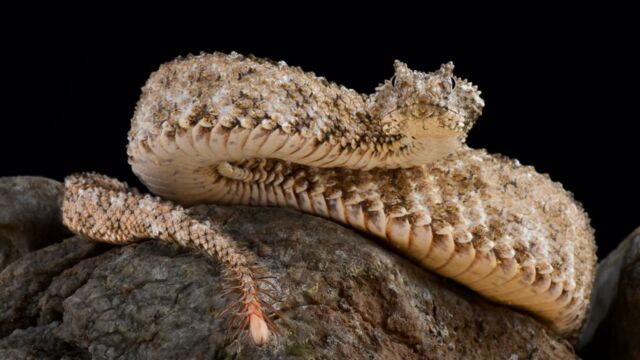This Iranian viper catches its prey by pretending to be... a spider!

This Iranian viper that came up with a formidable trick to catch the birds it has a taste for: luring them by pretending to be... a spider.
Meet the spider-tailed horned viper (Pseudocerastes urarachnoides). It lives in western Iran, and it has a very special body part. It has a spider-shaped lure at the end of its tail to attract birds
Discover our latest podcast
When it comes to predation, most animals have got nothing on snakes. These reptiles may not have legs, but they've developed formidable assets to hunt down their prey: remarkable agility, sharp hooks, a very mobile jaw, a powerful body, and venom.
More under this adMore under this adNot all species are playing with the same cards. Pythons, for example, kill their victims by smothering them, while cobras prefer to bank on their toxic fluid. Others choose to try their luck and go all in. That is the case of a viper that goes by the name of Pseudocerastes urarachnoides.
This species is mainly found in western Iran but has not been known for very long. Until 2001, the only viper listed was a misidentified specimen collected during an expedition to Iran in 1968. The tip of its tail was peculiar and was mistaken for a deformity.
More under this adMore under this adUpon observing other snakes endowed with the same anomaly, researchers realized that there was nothing abnormal there. In 2006, Pseudocerastes urarachnoides officially joined the global list of snake species, wowing researchers with its peculiarities.
The art of luring its prey
The viper has a light brown body adorned with darker markings. Its coloring allows it to blend perfectly with its natural habitat, which is made up of rocks and sand. Its skin is very scaly, and said scales extend to its head and its eyes, where two small horns stick out, hence its name: 'the horned viper.'
More under this adMore under this adBut what's most intriguing about it is what's at the end of its tail. In fact, the tip of its tail has a kind of bulb with thorns sticking out on both sides. Its shape is strangely reminiscent of a spider. Coincidence? We think not!
Scientists did have a hypothesis to explain this peculiarity. In 2015, they managed to confirm said hypothesis after conducting a three-year study. Their research allowed them not only to describe the feature in detail but also to observe it in action. Because this 'fake spider' isn't just an ornament.
More under this adMore under this adIn fact, it's a formidable weapon, more precisely a lure intended to attract the birds the viper feeds on. The method is simple: it meticulously wiggles the end of its tail to 'make the spider come to life' until its poor victim falls for the trick and approaches it. All it has to do then is attack.
According to the study, the snake reacts at lightning speed: it takes just 0.2 seconds for it to pounce on the bird. You can check it out in the video below.
More under this adMore under this adThe most elaborate of all of the snakes' lures
This snake isn't the only one to use a decoy to attract its prey. However, other snakes' lures' features are generally a lot simpler. It's often just a simple, colored tail extension that the predator wiggles. The spider-tailed horned viper's lure is the most elaborate of them all.
Observations revealed that, soon after the reptile's birth, the fake arthropod starts to grow from tapering scales that gradually develop at the tip that comes out of the tail. They reach their final form in adulthood and rise up when necessary.
More under this adMore under this adCamouflage, decoy, and venom. The horned viper appears to have found a winning trio to hunt without too much effort. During the study, however, the team observed that the tip could easily be damaged by pecks from hungry birds. Effective? Certainly, but not totally infallible!